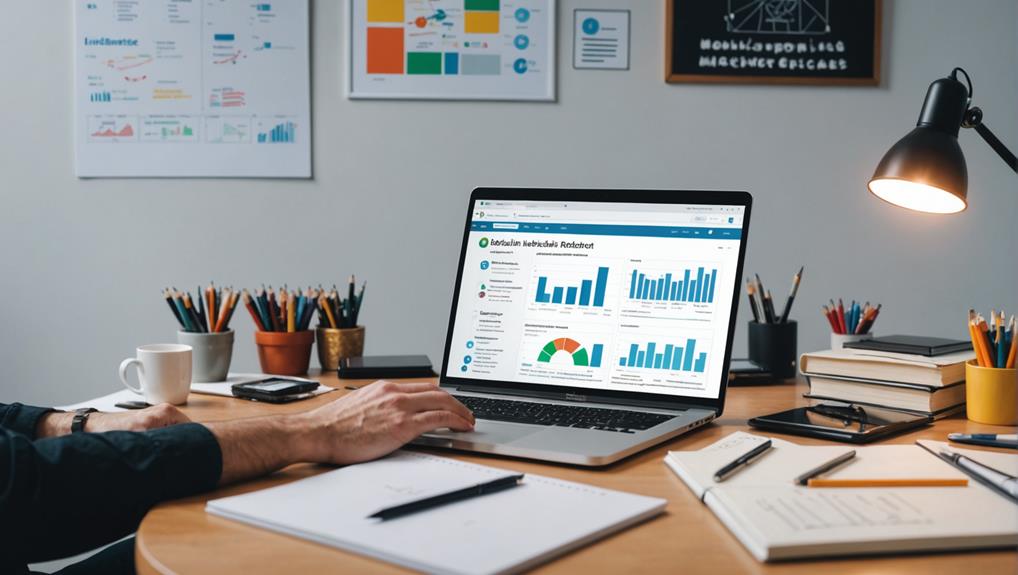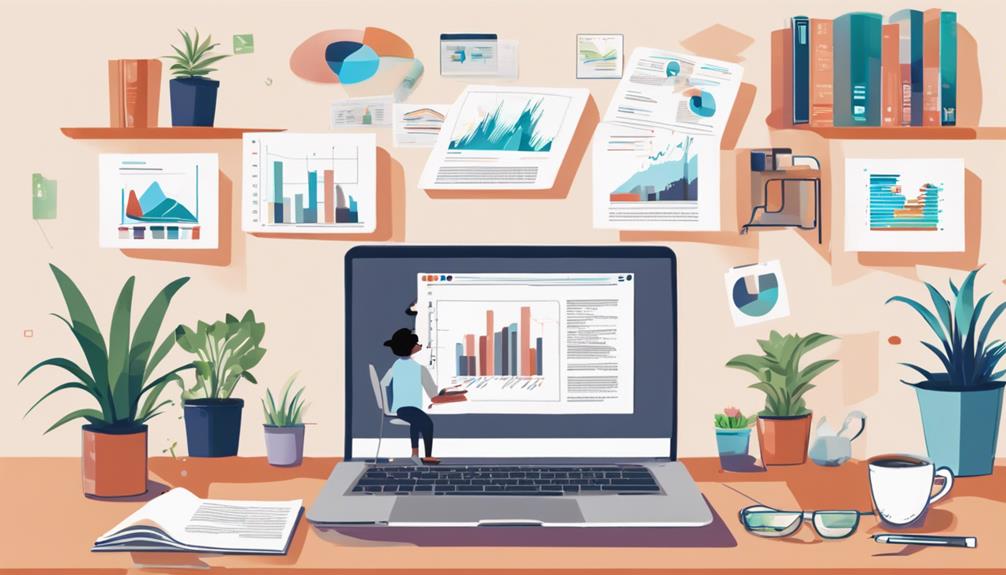
If you're looking to sharpen your professional skills using LinkedIn, you're in the right place. Engaging with thought leaders and tapping into educational content are just the beginning. By participating in professional groups and staying updated with industry trends through relevant hashtags, you can position yourself at the forefront of your field. However, the true secret lies in how you leverage these tools to foster meaningful interactions and continuous learning. Curious about how to effectively analyze discussions and practice reflective learning? Let's explore the potential of your LinkedIn activities to transform not just your network, but also your career trajectory.
Identify Key Industry Influencers

To effectively enhance your skills using LinkedIn, you should start by identifying key industry influencers. These are the seasoned professionals and rising stars in your field whose insights and updates can offer you invaluable guidance.
Dive into specific LinkedIn groups where these influencers are active; often, they share content or participate in discussions that aren't just promotional but are insightful and trend-setting.
Next, tailor your LinkedIn feed to prioritize posts from these influencers. Adjust your settings to follow them closely, ensuring their latest articles, posts, and shared content appear prominently in your feed.
This strategy keeps you abreast of the latest industry trends, techniques, and technologies that are shaping your field.
Don't just passively scroll through their posts. Take notes on the topics they discuss and the advice they offer. This isn't just about collecting information; it's about transforming that information into a practical knowledge base.
Reflect on how these insights apply to your current skills and projects. Identify gaps in your knowledge and seek out additional resources—maybe books, courses, or certifications—that these influencers recommend.
Engage With Thought Leaders
Once you've identified key industry influencers, actively engage with their content to deepen your understanding and expand your network.
Don't just scroll past their posts; take the time to read them thoroughly and think critically about the insights they're sharing. When you comment, go beyond simple affirmations like "Great post!" Instead, contribute meaningfully to the conversation. Ask thoughtful questions or share your own insights that relate to the topic discussed. This not only shows your engagement but also puts you on their radar, potentially leading to valuable interactions.
It's also beneficial to share their content with your network. When you do, add your own commentary explaining why you find it valuable or how it applies to your industry. This helps establish your own thought leadership and shows that you're not just passively consuming content, but actively synthesizing and adding to it.
Lastly, don't shy away from messaging these influencers directly if you have specific questions or need advice. Most are willing to help and appreciate genuine interest in their work.
Just ensure your messages are respectful and professional, highlighting what you admire about their work and what you hope to learn.
Utilize Educational Content

Building on your interactions with thought leaders, consider tapping into the wealth of educational content available on LinkedIn to further enhance your skills.
You'll find that many professionals and companies post tutorials, webinars, and articles that can provide you with new insights and advanced knowledge in your field.
Start by identifying leaders and organizations renowned for their expertise and contributions to your industry. They often share valuable content that not only informs but also challenges current practices.
This can be a fantastic opportunity for you to stay updated with the latest trends and technologies.
Don't just passively consume this information; engage with it. Comment on posts, ask questions, and even share your views.
This interaction can lead to a deeper understanding and possibly even personal connections with experts you admire.
Moreover, creating content based on what you learn and sharing it can establish you as a thoughtful participant in your field, inviting further engagement and opportunities.
Follow Relevant Hashtags
By following relevant hashtags on LinkedIn, you'll effortlessly keep up with the latest discussions and trends in your industry. This simple practice opens doors to a curated stream of content that's directly aligned with your professional interests and developmental needs.
Think of it as having a personalized news feed that delivers the most pertinent information without sifting through irrelevant posts.
Start by identifying the hashtags that are most influential in your field. Whether it's #DataScience, #DigitalMarketing, or #SustainableEngineering, these tags will connect you to the community that matters most to your career growth.
Once you follow these tags, your LinkedIn feed will begin to populate with insightful articles, thought leader publications, and real-time updates from industry events, ensuring you're always in the loop.
Don't just passively scroll through these posts. Engage with them by liking, commenting, and sharing. This interaction not only deepens your understanding but also increases your visibility in these circles.
As you engage, you solidify your presence as an active member of your professional community, making it easier to gain recognition and opportunities in your field.
Participate in Professional Groups

After following relevant hashtags, consider joining professional groups on LinkedIn to further enhance your network and skill set. These groups aren't just about networking; they're a resource pool where you can share insights, seek advice, and discuss industry trends without delving into specific ongoing discussions.
Engaging in these groups allows you to showcase your expertise and gain visibility among professionals who might be influential in your career trajectory. Don't just join any group; select those that align with your career goals and interests. This targeted approach ensures that the discussions you participate in are relevant and beneficial.
Once you're a member, actively contribute to conversations. Ask thoughtful questions and provide insightful answers. Remember, it's not just about taking information but also about giving back to the community. This reciprocity builds your reputation as a knowledgeable and helpful peer.
Also, leverage these groups to connect with mentors and peers who can provide guidance and feedback on your professional journey. Such relationships are invaluable as they often lead to opportunities outside the digital world.
Analyze Trending Discussions
Once you're comfortable navigating through LinkedIn's professional groups, start paying attention to trending discussions within these communities. These conversations often reflect the latest industry trends, common challenges, and innovative solutions that are at the forefront of your field.
By analyzing these topics, you'll not only stay updated but also gain valuable insights into how leaders and influencers are thinking and responding to changes.
To effectively analyze these discussions, look for posts that have a high level of engagement, such as those with many likes, comments, or shares. This indicates that the topic is resonating with a large number of professionals.
Dive into the comments section to understand different perspectives and responses. Notice which comments receive the most reactions or replies, as these often contain valuable opinions or additional information that can deepen your understanding of the subject matter.
Additionally, pay attention to the language and terminology used in these discussions. Industry-specific jargon and new concepts can be clues to emerging trends or shifts in professional standards.
This knowledge can be crucial for your career development, helping you to speak confidently about current topics in interviews or networking situations.
Practice Reflective Learning

Reflective learning transforms your experiences on LinkedIn into valuable lessons that enhance your professional growth. As you interact with posts, take a moment to consider what resonates with you and why.
It's not just about scrolling; it's about engaging deeply and thinking critically about the content you encounter.
Ask yourself: How does this information apply to my career or personal development? Can I implement any of these strategies in my current role? What worked for others, and why might it work (or not work) for me?
Writing down these reflections can solidify your understanding and help you make more informed decisions in the future.
You'll also benefit from sharing your reflections in your own LinkedIn posts. This not only cements your learning but also positions you as a thoughtful industry participant.
When you articulate what you've learned, you invite feedback that can further refine your perspectives and approaches.
Frequently Asked Questions
How Often Should I Update My Linkedin Profile?
You should update your LinkedIn profile whenever you gain new skills, complete significant projects, or change roles. Aim for at least a quarterly review to keep your information fresh and relevant.
What Time Is Best to Post on Linkedin?
To maximize visibility, you should post on LinkedIn early in the morning on weekdays, especially Tuesdays through Thursdays. This timing hits when most professionals check their updates before starting their workday.
Can Linkedin Posts Be Scheduled in Advance?
Yes, you can schedule your LinkedIn posts in advance using third-party tools like Hootsuite or Buffer. This helps you maintain consistency in your posting without having to be online all the time.
Is Premium Linkedin Worth the Investment?
Yes, LinkedIn Premium can be worth the investment if you're actively job searching or networking. You'll get better visibility, advanced search options, and useful insights that can greatly enhance your professional opportunities.
How Do I Handle Negative Comments on My Posts?
When you receive negative comments, respond professionally and calmly. Try to understand the feedback, and if it's constructive, use it to improve. Don't escalate; sometimes, it's best to ignore purely negative remarks.
Conclusion
Now you're equipped to boost your skills using LinkedIn posts. Start by identifying key influencers and engaging with thought leaders. Use educational content like tutorials and webinars to your advantage. Don't forget to follow relevant hashtags and participate in professional groups to stay on top of trends. Regularly analyze discussions and practice reflective learning to keep growing. By implementing these tips, you'll enhance your visibility and credibility, making meaningful connections that propel your professional journey forward.






